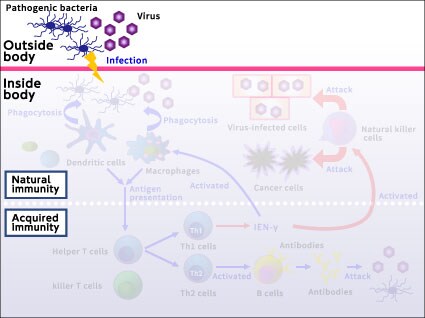|

What is the immune system? Relationship between lactic acid bacteria and people’s immune strength
Why is immunity important?
In winter, the common cold and influenza become widespread in society, but some people seem to catch these illnesses often while others do not. Why might that be? It has a lot to do with the immune system that each of us has. It’s surprising how those with strong immunity are able to fend off colds even if they are exposed to low temperatures or come in contact with others carrying highly infectious bacteria and viruses.
The immune system, which is the greatest defense mechanism of our body, is constantly working to keep us healthy by eliminating or combating harmful exogenous agents such as bacteria and viruses that enter the body from outside. As the immune system functions within our bodies, we are protected from incoming pathogens and other harmful substances at all times.
Immune mechanism
Let’s see how the immune system functions inside our bodies. The immune system can be classified into two subcategories, one being the innate immune system and the other being the acquired system. The innate immune system can be described as the forefront of the immune system. It consists of NK cells, phagocytes*1, antigen-presenting cells*2, etc. that initially attack cells that are infected with intruding viruses. Then, there is the acquired immune system as the second line of defense, mainly consisting of B cells that secrete antibodies for attacking specific bacteria and viruses, and T cells, which serve to regulate B cells.
However, the immune strength of the body deteriorates due to various factors such as poor dietary habits, aging, and stress. When one is exposed to these risk factors, the body becomes more prone to catching a cold and other communicable diseases and even developing cancer. Also, in terms of age groups, small children and seniors tend to have low immune strength. And lactic acid bacteria, which are one of the good bacteria, are closely related to such key immune functions.
*1: Cells that engulf and neutralize harmful foreign substances such as bacteria and viruses
*2: Cells that display pieces of pathogens that have entered the body and activate T cells
Key points on immunity
■Point 1
To avoid catching diseases, it’s important to increase your immune strength!
■Point 2
Stress and dietary habits affect your immune strength. Lactic acid bacteria are highly relevant to your immune functions!

Immune age test
Your immune strength deteriorates due to aging and exposure to stress. You can check your immune age right now just by answering 20 simple questions!
|

|
Feature: What is the difference between bacteria and viruses?
Bacteria have cells and can reproduce on their own. On the other hand, viruses are particles carrying only their genetic information, and replicate only inside the cells of other organisms. While bacteria attack other organisms’ cells from outside by secreting toxins, viruses do so from within the host cells that they infect.
When bacteria get into human blood and other body fluids, they are met with humoral immunity that secretes antibodies to attack them. Meanwhile, if viruses infect human cells, they are dealt with by cellular immunity that unleashes cytotoxic T cells to destroy the infected cells.
Immune mechanism

 |
When bacteria and viruses enter the body, the nasal hair, mucosa, and skin serve as the primary barriers to block their advance. However, some bacteria and viruses may penetrate these barriers and enter the body. |
Immune mechanism

 |
When bacteria and viruses succeed in getting inside the body, the innate immune system is there to rapidly respond to the intruders. The innate immune system immediately detects and attacks any foreign antigens*1 that enter the body. As for the NK cells that form an important part of the innate immune system, they are natural born killers as the name indicates. NK cells are able to quickly notice any virus-infected cells, cancer cells, and other abnormal cells and dispose of them. Meanwhile, phagocytes such as macrophages and dendritic cells are able to capture inside their own cells any antigens such as bacteria and viruses as well as dust and other foreign particles and neutralize them with enzymes. Cytokines are another key component of the innate immune system, as they convey cell signals between the innate and acquired immune systems.
※1Bacteria, viruses, etc. that trigger an immune response in the living body.
|
Immune mechanism

 |
No matter how hard the innate immune system works by engulfing and destroying incoming antigens, not all of them can be eliminated. That’s when the acquired immune system kicks in. The acquired immune system is activated when antigens are presented by macrophages and dendritic cells (which are called antigen-presenting cells).
In the acquired immune system, T cells are like an elite squad of immune cells. They are like special mercenaries trained to defeat strong pathogens. There are several different types of T cells. Killer T cells destroy virally infected cells and cancer cells by binding to them. Meanwhile, helper T cells assist in enhancing immune strength, by commanding B cells to produce antibodies (Th1 and Th2 cells are subgroups of helper T cells). If these cells continue with their immune responses even after unwanted intruders are neutralized, that could harm the body they are intended to protect. Therefore, regulatory T cells come in to end the immune reactions. B cells secrete antibodies that are suitable for attacking each targeted antigen type. |
Immune mechanism

|









